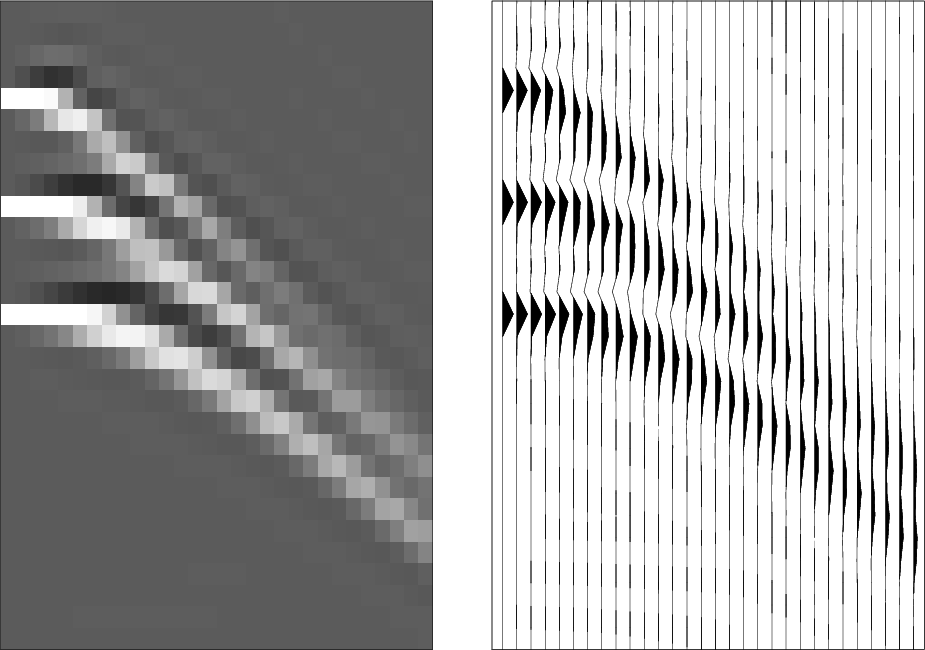|
|
|
|
Solution steering with space-variant filters |
At this point a discussion of steering filters is appropriate. Plane waves with a given slope on a discrete grid can be predicted (destroyed) with compact filters (Schwab, 1997). Inverting such a filter by the helix method, we can create a signal with a given arbitrary slope extremely quickly. If this slope is expected in the model, the described procedure gives us a very efficient method of preconditioning the model estimation problem, fitting goal (2).
How can a plane prediction (steering) filter be created? On the helix surface,
the plane wave
![]() translates naturally into a
periodic signal with the period of
translates naturally into a
periodic signal with the period of
![]() , where
, where ![]() is
the number of points on the
is
the number of points on the ![]() trace, and
trace, and
![]() , where
, where ![]() is the plane slope,
is the plane slope,
![]() and
and ![]() and
and ![]() correspond to the mesh size.
If we design a filter that is two columns long
(assuming the columns go in the
correspond to the mesh size.
If we design a filter that is two columns long
(assuming the columns go in the ![]() direction), then the plane
prediction problem is simply connected with the
interpolation problem: to destroy a plane wave, shift the
signal by
direction), then the plane
prediction problem is simply connected with the
interpolation problem: to destroy a plane wave, shift the
signal by ![]() , interpolate it, and subtract the result from the
original signal. Therefore, we can formally write
, interpolate it, and subtract the result from the
original signal. Therefore, we can formally write
Different choices for the operator ![]() in (6)
produce filters with different length and prediction power.
A shifting operation corresponds to the filter with the
in (6)
produce filters with different length and prediction power.
A shifting operation corresponds to the filter with the ![]() -transform
-transform
![]() , while the operator
, while the operator ![]() corresponds to an
approximation of
corresponds to an
approximation of ![]() with integer powers of
with integer powers of ![]() . One possible
approach is to expand
. One possible
approach is to expand
![]() using the Taylor series around
the zero frequency (
using the Taylor series around
the zero frequency (![]() ). For example, the first-order approximation
is
). For example, the first-order approximation
is

|
|---|
|
steer-lagrange
Figure 2. Steering filters with Lagrange interpolation. The left and middle plots show the impulse responses of steering filters: the top panel corresponds to linear interpolation (two-point Lagrange, upwind finite-difference); the second top plot, the three-point Lagrange filter (Lax-Wendroff scheme); the two bottom plots, the 8-point and 13-point Lagrange filters. The right plots in each panel show the corresponding average spectrum. The spectrum flattens and the prediction get more accurate with an increase of the filter size. |
|
|
The second-order Taylor approximation yields
If instead of Taylor series in ![]() , we use a rational (Padè)
approximation, the filter will get more than one coefficient in the
first row, which corresponds to an implicit finite-difference scheme.
For example, the
, we use a rational (Padè)
approximation, the filter will get more than one coefficient in the
first row, which corresponds to an implicit finite-difference scheme.
For example, the ![]() Padè approximation is
Padè approximation is
It is interesting to note that a space-variant convolution with
inverse plane filters can create signals with different shape, which
remains planar only locally. This situation corresponds to a variable
slowness ![]() in the one-way wave equation (9). Figure
3 shows an example: predicting hyperbolas with a 7-point
Lagrangian filter.
in the one-way wave equation (9). Figure
3 shows an example: predicting hyperbolas with a 7-point
Lagrangian filter.

|
|---|
|
steer-hyp7
Figure 3. Creating hyperbolas with a variant plane-wave prediction: the impulse response of the inverse 7-point time-and-space-variant Lagrangian filter. |
|
|
|
|
|
|
Solution steering with space-variant filters |